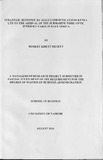| dc.description.abstract | The Internet has had a relatively brief, but explosive history. It grew out of an experiment begun in the 1960s by the U.S. Department of Defence (DoD). The DoD wanted to create a computer network that would continue to function in the event of a disaster, such as a nuclear war. This was so if part of the network was damaged or destroyed, the rest of the system still had to function.
Right from the advent of the internet in Kenya in the 1990's- unlike other continents of the world- little has changed since all forms of internet connectivity have mostly been satellite- based until June 2009 when the first submarine optical fibre cables landed on the East cost of Africa, courtesy of the Seacom cable. It was soon followed by the government-lead TEAMS cable by the end of the same year.
The arrival of these cables marked the end of our over-reliance on satellite as the only gateway to the internet backbone. Just like most of Africa, Kenya had for years been dependent on satellite communication- VSAT and related variants- for her internet needs. Prior to the liberalization of the telecommunication sector in the country, the state monopoly, TKL, was the only gateway to the internet backbone through its earth stationed at Suswa, off the Narok road. However the liberalization of the market saw the proliferation of many service providers and ISPs offering a myriad of solutions. ACKL was one such company.
The objective of this case was to establish the strategies that Afsat Communications Kenya Limited (ACKL) has adopted in order to counter the effects that the arrival of the sub-marine cables have exerted on its business in Kenya. ACKL was formed on the premise of providing fast and reliable internet connectivity to corporate entities in the country through VSAT. Its design was unique and revolutionary in the market because it could provide clients direct connectivity to the internet without going through many intermediaries as had been the case with TKL and other service providers. This uniqueness in network design saw ACKL's client base and revenues grow at an almost exponential rate from 2005 until 2009. These clients were mostly NGOs, the United Nations and many other high-spending international organizations that appreciated the reliability of service.
The objective of this case was to establish the strategies that Afsat Communications Kenya Limited (ACKL) has adopted in order to counter the effects that the arrival of the sub-marine cables have exerted on its business in Kenya. From the study, it was evident that the arrival of the cables has resulted in significant revenue and client loss. The respondents pointed out that even though the company has lost significantly with the arrival of the cables, it has the potential of recouping these losses if the measures it has put in place are aggressively pursued. They explained that there is a lot of potential owing to the fact that ACKL is owned by Telkom South Africa (TSA). TSA can leverage its resources and experience in other African markets in making ACKL regain its foothold. | en_US |

